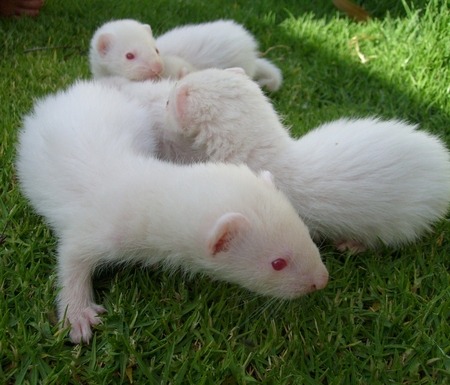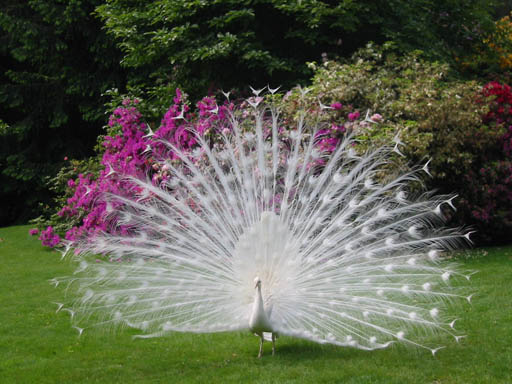|
|
|---|
Saturday, July 17, 2010
The Scimitar-Horned Oryx is a very interesting animal, and here are some of the main reasons why:
1. It comes from Africa, just like basenjis do.
2. It is extinct in the wild, but there are a bunch of them in zoos.
3. If you say "oryx" several times in a row, it sounds funny, like a parrot squawking.
There are several kinds of oryxes, but this particular kind got its name because it has long, curved horns that look like scimitars. And in case you don't know what a scimitar is, it's a curved sword thingy that people used to fight with in places like the Middle East and North Africa. The horns on an oryx can be as long as 3 or 4 feet, so these animals have to be careful when they are going through low doorways.
Oryxes are mostly whitish in color, but they also have some reddish brown on their necks and faces. A male oryx can weigh 440 pounds, which is equal to about 20 basenjis. Mostly, the oryxes lived farther north in Africa than the basenjis did, though. They didn't live in the Sahara Desert, but they lived either just north of it or just south of it, where there were some trees and shrubs and grass and yummy stuff like that to eat.
Another thing that oryxes need is water, but they don't need as much of it as you might think. And that is because oryxes have a special way of storing up water in their kidneys instead of peeing it all out. And also they can make their bodies hotter, like as hot as 116 degrees, so that they don't sweat.
There used to be thousands and thousands of scimitar-horned oryxes in Africa, and they lived in big herds because they like to be chummy with other oryxes. Usually, a herd was between 20 and 40 animals, but when they were migrating, there might be 1,000 or more of them all traveling together.
But then, when more and more people started living in Africa, bad things happened to the oryxes. The worst thing was that people hunted the oryxes, and sometimes they did it because they needed food, but other times they did it because they wanted the horns, or maybe they just thought it was fun to shoot animals. And when people started using trucks and modern guns, they found out it was easy to kill lots and lots of oryxes. And even though you can't hunt oryxes in Africa anymore because they're all gone, you can pay about $2,250 and go hunt them in Texas. I read about this on the internet, so I know it is true.
Anyway, about the same time people were shooting oryxes in Africa, the Sahara started getting bigger, so there wasn't as much food for the oryxes. Plus the food that was there got eaten by cattle. So after a while, the only oryxes left were the ones in zoos and places like that. In 1996, there were 1,250 oryxes in captivity around the world, and there were 2,145 on ranches in Texas. Right here in Kansas City, at the zoo, 8 baby oryxes were born this year.
Anyway, there is a plan to bring some of these animals back to Africa and let them live in the wild again. A herd of them is already living in a fenced preserve in Tunisia, and there are also some in Israel. And soon Niger may have some, too.
So someday maybe lots of nice oryxes will get to live in Africa again, just like their ancestors did. But until then, you can probably go see them at your local zoo.
1. It comes from Africa, just like basenjis do.
2. It is extinct in the wild, but there are a bunch of them in zoos.
3. If you say "oryx" several times in a row, it sounds funny, like a parrot squawking.
There are several kinds of oryxes, but this particular kind got its name because it has long, curved horns that look like scimitars. And in case you don't know what a scimitar is, it's a curved sword thingy that people used to fight with in places like the Middle East and North Africa. The horns on an oryx can be as long as 3 or 4 feet, so these animals have to be careful when they are going through low doorways.
Oryxes are mostly whitish in color, but they also have some reddish brown on their necks and faces. A male oryx can weigh 440 pounds, which is equal to about 20 basenjis. Mostly, the oryxes lived farther north in Africa than the basenjis did, though. They didn't live in the Sahara Desert, but they lived either just north of it or just south of it, where there were some trees and shrubs and grass and yummy stuff like that to eat.
Another thing that oryxes need is water, but they don't need as much of it as you might think. And that is because oryxes have a special way of storing up water in their kidneys instead of peeing it all out. And also they can make their bodies hotter, like as hot as 116 degrees, so that they don't sweat.
There used to be thousands and thousands of scimitar-horned oryxes in Africa, and they lived in big herds because they like to be chummy with other oryxes. Usually, a herd was between 20 and 40 animals, but when they were migrating, there might be 1,000 or more of them all traveling together.
But then, when more and more people started living in Africa, bad things happened to the oryxes. The worst thing was that people hunted the oryxes, and sometimes they did it because they needed food, but other times they did it because they wanted the horns, or maybe they just thought it was fun to shoot animals. And when people started using trucks and modern guns, they found out it was easy to kill lots and lots of oryxes. And even though you can't hunt oryxes in Africa anymore because they're all gone, you can pay about $2,250 and go hunt them in Texas. I read about this on the internet, so I know it is true.
Anyway, about the same time people were shooting oryxes in Africa, the Sahara started getting bigger, so there wasn't as much food for the oryxes. Plus the food that was there got eaten by cattle. So after a while, the only oryxes left were the ones in zoos and places like that. In 1996, there were 1,250 oryxes in captivity around the world, and there were 2,145 on ranches in Texas. Right here in Kansas City, at the zoo, 8 baby oryxes were born this year.
Anyway, there is a plan to bring some of these animals back to Africa and let them live in the wild again. A herd of them is already living in a fenced preserve in Tunisia, and there are also some in Israel. And soon Niger may have some, too.
So someday maybe lots of nice oryxes will get to live in Africa again, just like their ancestors did. But until then, you can probably go see them at your local zoo.
0 Comments:
Subscribe to:
Post Comments (Atom)



















